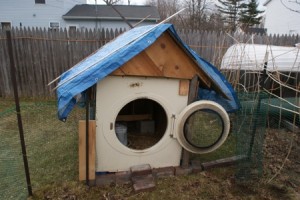
In the great American pastime of keeping chickens, one must first procure housing for said fowl. Chickens are not particular in their tastes in lodging, but do need protection from predators and the elements. Prefabricated coops can be purchased, but substantial savings can be had by constructing a coop oneself. A sensible person might ask himself/herself what one needs to build said coop: lumber, nails, chicken wire, etc. However, in the true spirit of American ingenuity that embodies the best of hillbilly engineering, one instead asks “What do I have laying around the house and yard?” It might be an old piece of exercise equipment, a diaper-changing table, a broken appliance, even an old sewing machine can be put to good use as ballast. The possibilities are limited only by the engineer’s imagination.
In 2009, BackyardChickens.com hosted a Tacky Coop Contest. The rules of the contest were simple: The coops must be homemade and no chickens could die as a result of being kept in said housing. In other words, the coop must be safe and useable. That’s all. While there are plenty of chicken coops built to resemble a doll’s house or a country cottage or St. Basil’s Cathedral, these are not the focus of the contest or this article!
The submissions to the Tacky Coops contest exceeded my expectations in every way. I was struck by the spectacular ingenuity of design and the absolute triumph of function over form. The designers freed themselves from the accepted limitations of aesthetics and Euclidean geometry. I must admit that after viewing several of the best submissions, I was so overcome by emotion that I had to step away from the computer for several minutes to regain my composure. I noticed several recurring themes, such as the use of zip ties, bailing twine, blue plastic tarps and cinder blocks. Other than that, each coop is completely unique. Behold the following stunning submissions.

In Fig. 2 you will notice a pronounced lack of right angles. The chickens don’t care that nothing is plumb or level or that the coop seems to be precariously balanced on cement blocks. They seem proud of the jaunty angles and aged lumber. There is no reason that a coop need conform to the building aesthetics of the homeowner. (It should be noted, however that as the house is not in view, I am only speculating that its construction is not represented by the chicken coop.)

Who else but a master hillbilly engineer could have foreseen that an old trampoline could convert into such a winsome coop (Fig. 3). The metal frame of the trampoline has been rebuilt into the structural frame of the run area of the coop, and wooden palates are used to form the hen house in the back. Notice that the jumping surface of the trampoline is used as a cover to keep rain off of the run area. All that the owner had to supply was the wire fencing and some zip ties to hold it in place. This coop design is especially ingenious as it was able to be reconfigured into a new shape to provide a larger run area in Fig. 4.
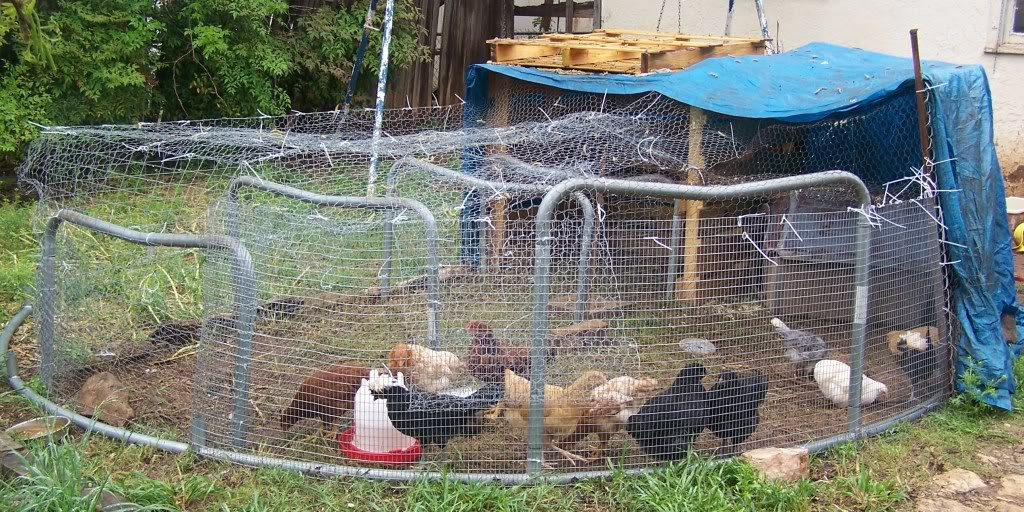
Here the round trampoline shape is preserved to maximize the surface area of the run. Notice the henhouse made of palates this time is covered with a blue tarp. When it was pointed out to the owner that he could cut off the ends of the zip ties, he responded “That would ruin the effect.”
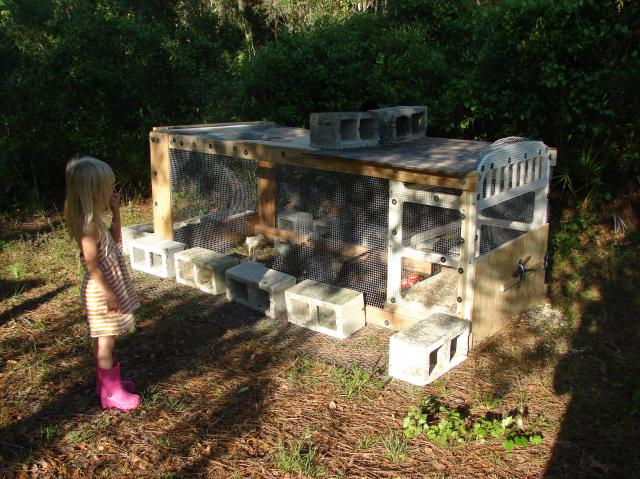
It would never occur to most of us that an old diaper-changing table could be incorporated into a chicken coop as a primary structural feature. The resulting coop is quite sturdy and secure. Cinderblocks anchor the skirted wire sides to prevent predators from digging under it. Notice the preschooler gazing wistfully at the changing table, perhaps recalling fond memories. Now she can be reminded of her diapered past every time she visits her beloved chickens in the back yard.

This small coop is made of an old dog house and a soccer goal. To keep everything from blowing away, it is held in place by an old sewing machine and a car battery and various other flotsam and jetsam. Note again the zip ties with the cords left on. You can see in this picture that building materials were not in short supply. I’m surprised that the chairs were not also incorporated somehow into the design.

This next design stands in stark departure from the previous designs. Here we see extremely sturdy construction. Said the designer/owner, “I really outdid myself with this one!” He built this setup without having any actual experience with raising chickens or any knowledge of their dimensions. The henhouse is 12 inches by 12 inches and can only house two bantam chickens. Apparently he thought that chickens are tiny but monstrously strong! It was remarked that the busted-up car in the background is an especially nice touch and why didn’t he just convert that into a coop? “I’m holding out for a school bus.”
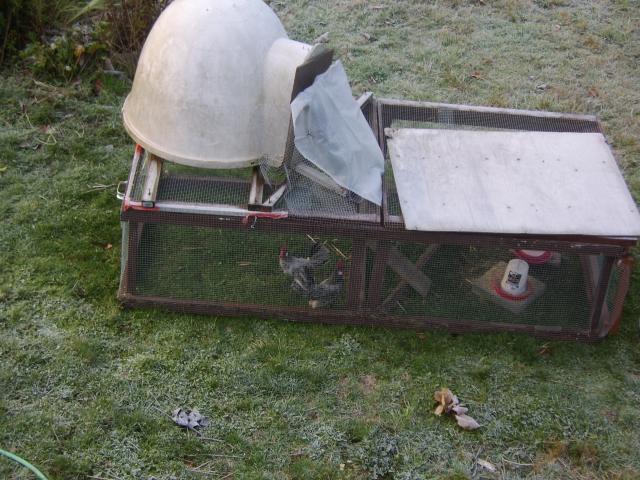
No coop contest would be complete without a moveable coop, or “chicken tractor.” This concept allows the chickens a fresh grazing area simply by dragging the coop to a new spot in the yard each day. In the elegantly simple design in Fig. 8, a dogloo was placed on top of some crates, forming a two-level moveable coop. Notice the wooden plank and plastic-covered conduit allowing passage from the upper to the lower level. I can only imagine how envious the neighbors must be.
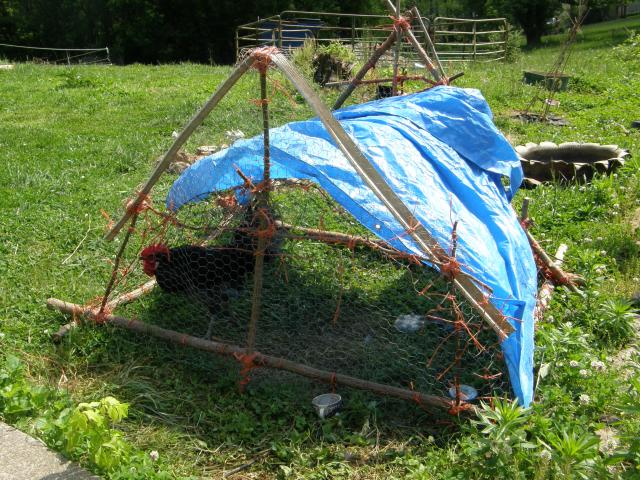
Here we see another chicken tractor, this time housing a single rogue rooster. This isolation was necessary to prevent him from terrorizing the hens and neighborhood pets and children. This cozy shelter was fashioned from some fallen branches and bent aluminum siding. The orange bailing twine looks particularly festive contrasting the blue plastic tarp. That is one proud rooster!
The above coops all demonstrate that when you think outside the litter box and free yourself from the commonly-accepted confines of aesthetics and building codes, you can achieve breathtaking results. The chickens are quite happy with their repurposed housing and challenge you to find fault with their coops (See Fig. 10).
Viewing the results of the Tacky Coops Contest has had a transformative effect on me, as I hope it has for you. Now I will never look at old furniture or exercise equipment the same way. Even if you do not want to keep chickens, everything can be used as something else. Why simply toss everything into the dump as soon as it is no longer able to serve its nominal purpose? For example, I could turn an old bookcase into a rabbit hutch. I could use our hot tub to raise fish. The possibilities are limitless! You too can turn the ordinary into something extraordinary when you just use your imagination.

All images from BackyardChickens.com except Toilet Garden.
